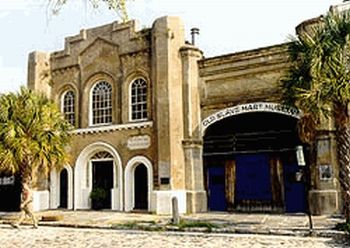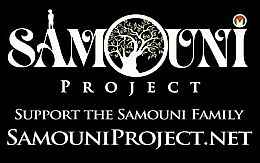
Publisher:
Bonnie King
CONTACT:
Newsroom@Salem-news.com
Advertising:
Adsales@Salem-news.com

~Truth~
~Justice~
~Peace~
TJP
May-24-2011 16:05

 TweetFollow @OregonNews
TweetFollow @OregonNews
Charleston: A Hodgepodge of Impressions, Trivia, and History
By Ralph E. Stone & Judi Iranyi Salem-News.com"History, despite its wrenching pain, cannot be unlived, but if faced with courage, need not be lived again." - Maya Angelou
 The Old Slave Mart Museum in Charleston, SC |
(SAN FRANCISCO) - Earlier this month, we spent an enjoyable, informative week-long visit to Charleston, South Carolina. We had no idea that Charleston was observing the Civil War Sesquicentennial (150) until after our arrival. As a result, we were able to brush up on our Civil War history. That is, mostly from a southern point of view. What follows is a hodgepodge of trip impressions, trivia, and Civil War history.
We spent most of our time in the historical or downtown section of Charleston. Charleston lies between the Cooper and Ashley Rivers, which meet at the Charleston harbor. The Battery is a park area with grand homes facing the harbor. Meeting Street splits the historical section and is called Charleston's Museum Mile, which includes the Charleston Museum (the oldest museum in the U.S.), other museums, galleries, and historical houses. It is a beautiful city drawing tourists mainly from other parts of South Carolina, Georgia, North Carolina, and Maryland and occasionally from San Francisco.
Except for a secession gala held in December 2010, reportedly the 150 observance went smoothly. The Centennial observance In 1961, on the other hand, went quite differently. The official National Civil War Centennial Commission divided in Charleston over the segregation of local facilities. A group seceded and formed their own S.C Confederate Centennial Commission, which bashed the Kennedy administration and the civil rights movement. The centennial was all about secession, nothing about slavery.
The Sesquicentennial did go out of its way to point out that Charleston's economic and political power were attained on the backs of thousands and thousands of slaves. As of 1860 the percentage of Southern families that owned slaves has been estimated to be 43 percent in the lower South, including South Carolina. Half the owners had one to four slaves. A total of 8000 planters owned 50 or more slaves in 1850. According to the 1860 U.S. census, 393,975 individuals, representing 8 percent of all U.S. families, owned 3,950,528 slaves.
As you remember, before Abraham Lincoln took office, the South Carolinas State Convention assembled in Columbia, SC, in December 1860 to decide whether the state should remain in the Union. The delegates unanimously agreed that South Carolina should secede. Due to the presence of smallpox in Columbia, the Convention adjourned to Charleston. There, on December 20, the Convention formally declared "that the union now subsisting between South Carolina and other States, under the name of 'The United States of America' is hereby dissolved." An Ordinance of Secession was then signed by all delegates.
South Carolina's "Declaration of the Causes of Secession" frames the issue as a state's rights or property rights issue.. That is, under a compact theory of the Union, the U.S. was a voluntary association of sovereign states which had created a compact under the Constitution and formed a federal government to secure their common benefit. And should a state's interests be threatened, a state might withdraw and resume independence. South Carolina believed that this good-faith compact had been deliberately broken and disregarded by the non-slaveholding states. In addition, Abraham Lincoln, hostile to slavery, had been elected president. Therefore, the federal government had become an enemy of state's rights, domestic sovereignty, and self-government. South Carolina seceded from the Union and "resumed her position among the nations of the world."
The Fugitive Slave Act was passed in 1850. This Act declared that slaves who escaped to free states must be forcibly returned to their masters. This Act was regularly disregarded by the abolitionists. When U.S. Senator Jefferson Davis left Congress to become the president of the Confederate States of America, he specifically denounced nullification of the Act in his farewell address. I recommend "Soul Catcher" by Michael C. Wright, about a slave or soul catcher hired to bring back an escaped slave.
 |
Abraham Lincoln's position on slavery was somewhat ambivalent. In 1862, he wrote: "My paramount object in this struggle is to save the Union, and is not to either to save or to destroy slavery. If I could save the Union without freeing any slave, I would do it; and if I could save it by freeing all the slaves, I would do it; and if I could save it by freeing some and leaving others alone, I would also do that." Southerners love this quote.
We took a 30-minute ferry ride to Fort Sumter located at the entrance to Charleston harbor. When South Carolina seceded, it demanded that all Union fortifications be turned over to the state, but the Union refused to surrender Fort Sumter. U.S. Major Robert Anderson commanded the fort. He was undermanned and undersupplied. Lincoln sent a ship with reinforcements and supplies, but before it reached the fort, Brigadier General P.G.T. Beauregard, who commanded the Confederate forces, fired on Fort Sumter from nearby Fort Johnson. This was the first shots fired in the Civil War. As a side note, Major Anderson was one of General Beauregard's instructors at West Point. Ultimately, Major Saunders surrendered and the Union troops were allowed to evacuate. No one was killed during the bombardment of Fort Sumter. Some have speculated that Lincoln induced the Confederate's to fire the first shots on Fort Sumter so as to be able to declare a rebellion by the Confederate states. The Civil War had begun.
We visited the Magnolia Plantation and Gardens about ten miles from Charleston. It once was a rice growing plantation, but since the end of slavery, the plantation and its beautiful gardens fell into disrepair. Now the plantation and gardens have been restored and is a favorite spot for tourists. Pre-Civil War, South Carolina was the leading rice growing area in the U.S. South Carolina planters discovered that rice imported from Asia grew well in South Carolina's low country, but the planters had little luck growing crops. They soon recognized the advantage of importing slaves from the traditional rice-growing region of West Africa, They generally showed far greater interest in the geographical origins of African slaves than did planters in other North American colonies. The South Carolina rice planters were willing to pay higher prices for slaves from the "Rice Coast," the "Windward Coast," the "Gambia," and "Sierra-Leon"; and slave traders in Africa soon learned that South Carolina was an especially profitable market for slaves from those areas. The South Carolina and Georgia colonists ultimately adopted a system of rice cultivation that drew heavily on the labor patterns and technical knowledge of their African slaves.
Clearing and draining swampland and building and maintaining the system of sluices, banks, and ditches, and planting and sowing crops was a dawn-to-dusk, backbreaking work. Once slavery ended, without cheap slave labor, the plantations slowly reverted back to its natural state.
Many of the large plantation owners used the plantation only during planting and harvesting season. Most had mansions in Charleston where they spent the "social" season. We visited the Heyward-Washington House built in 1772; the Joseph Manigault House built in 1803; the Aiken-Rhett House built in 1820; and the Nathaniel Russell House built in 1808. Each household had from 10 to 15 slaves to run the household. The slaves usually lived in shabby quarters behind the mansion or over the stables. The kitchens were in separate buildings because of fear of fire. There was no running water or indoor toilets. Nanthaniel Heyward, by the way, owned 1,843 slaves on three plantations. While William Aiken, governor of South Carolina (1844-1846), owned 904 slaves on his plantation.
Charleston was a major port. Pirates such as Blackbeard, Stede Bonney, and Charles Vane preyed on ships entering or leaving Charleston. Stede Bonney was finally caught and hung in Charleston.
George Gershwin read DuBose Heyward's novel "Porgy" in 1924 and thought it could be adapted as an opera. He composed "Porgy and Bess" in 1934 in collaboration with Heyward at Folly Beach just outside of Charleston.
Charleston is the home of the Charleston RiverDogs, a Class A affiliate of the New York Yankees. Imagine a South Carolina team affiliated with an organization called the "Yankees." Actor Bill Murray is listed as the team's "Director of Fun."
Our visit to The Old Slave Mart Museum reminded us of the "why" of the Civil War. It wasn't really about state's rights or property rights. (Slaves, of course, were the property in question.) No matter how you spin it, the Civil War was about the abomination called slavery. In 1808, the U.S. banned the international slave trade, but despite government efforts about 250,000 slaves were smuggled into the U.S. from 1808 until the Civil War. And the U.S. ban did not cover slaves born in the U.S.
Charleston was a center for the buying and selling of slaves with about 40 slave marts or auction places. By treating a race or an ethnic group as less than human, enslaving them became easier. That's basically what happened in slaveholding states. For example, the South Carolina Slave Code of 1740 prohibited teaching a slave to read or write, a slave could not testify in court, and a slave could be executed for plotting to run away. Slaveowners came to view Blacks as lazy, mentally inferior, and naturally promiscuous. Selling away a family member was viewed as only a temporary hardship for the slaves involved. Even religious leaders preached that slaves were born to be slaves, must work hard for their masters, and never disobey, lie or steal.
Slaves were brought to the slaves marts and housed in dungeon-like rooms. Shackles and chains were removed to let wounds heal. They were then examined by physicians to make sure they were healthy; rations were increased to fatten them up; they were made to dance or exercise to tone up their muscles; their skin was greased to give them a healthy glow; grey hair was plucked or dyed; and women's hair was oiled. Then the slaves were put up for auction. Prices ranged from $600 to $1,900. A slave with special skills, such as carpentry, iron work, etc., fetched a higher price.
Why do we teach history? Maya Angelou put it nicely: "History, despite its wrenching pain, cannot be unlived, but if faced with courage, need not be lived again."
 Salem-News.com writer Ralph E. Stone was born in Massachusetts. He is a graduate of both Middlebury College and Suffolk Law School. We are very fortunate to have this writer's talents in this troubling world; Ralph has an eye for detail that others miss. As is the case with many Salem-News.com writers, Ralph is an American Veteran who served in war. Ralph served his nation after college as a U.S. Army officer during the Vietnam war. After Vietnam, he went on to have a career with the Federal Trade Commission as an Attorney specializing in Consumer and Antitrust Law. Over the years, Ralph has traveled extensively with his wife Judi, taking in data from all over the world, which today adds to his collective knowledge about extremely important subjects like the economy and taxation. You can send Ralph an email at this address stonere@earthlink.net
Salem-News.com writer Ralph E. Stone was born in Massachusetts. He is a graduate of both Middlebury College and Suffolk Law School. We are very fortunate to have this writer's talents in this troubling world; Ralph has an eye for detail that others miss. As is the case with many Salem-News.com writers, Ralph is an American Veteran who served in war. Ralph served his nation after college as a U.S. Army officer during the Vietnam war. After Vietnam, he went on to have a career with the Federal Trade Commission as an Attorney specializing in Consumer and Antitrust Law. Over the years, Ralph has traveled extensively with his wife Judi, taking in data from all over the world, which today adds to his collective knowledge about extremely important subjects like the economy and taxation. You can send Ralph an email at this address stonere@earthlink.net
Articles for May 23, 2011 | Articles for May 24, 2011 | Articles for May 25, 2011
Quick Links
DINING
Willamette UniversityGoudy Commons Cafe
Dine on the Queen
Willamette Queen Sternwheeler
MUST SEE SALEM
Oregon Capitol ToursCapitol History Gateway
Willamette River Ride
Willamette Queen Sternwheeler
Historic Home Tours:
Deepwood Museum
The Bush House
Gaiety Hollow Garden
AUCTIONS - APPRAISALS
Auction Masters & AppraisalsCONSTRUCTION SERVICES
Roofing and ContractingSheridan, Ore.
ONLINE SHOPPING
Special Occasion DressesAdvertise with Salem-News
Contact:AdSales@Salem-News.com

googlec507860f6901db00.html



Terms of Service | Privacy Policy
All comments and messages are approved by people and self promotional links or unacceptable comments are denied.
[Return to Top]
©2025 Salem-News.com. All opinions expressed in this article are those of the author and do not necessarily reflect those of Salem-News.com.